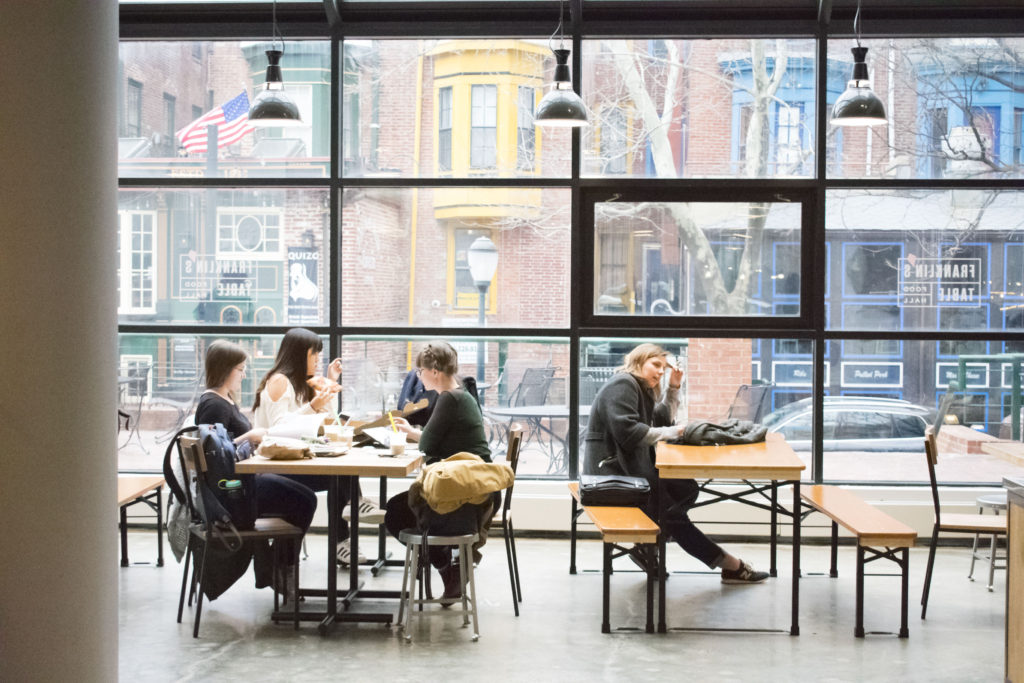Why I am Boycotting Franklin’s Table
Surprise surprise, Penn has created a space that excludes the poor.

Article by Justin Guo
Photos by Alice Deng
Around lunchtime a few days ago, I went to Franklin’s Table, the same way many of us have been eating recently at this new upscale fast-casual food court. The prices are high — almost every food truck on campus will run you under 7 dollars for a meal — but admittedly the food is quite good, almost worth it.

Too bad Goldie required a 30 minute wait. Fine. I had a friend to keep me company, and had time to burn. I get up to the register and once I finish paying, I overhear behind me — “do you accept cash?” A quick, polite “no, sorry” from the cashier, and poof the man is gone by the time I turn around. I remember who was standing behind me. Sandwiched between black fur-lined jackets, a normal middle-aged hispanic man wearing a construction t-shirt and dirty jeans. Not to pass judgement, but he’s probably not particularly rich — at least compared to the rest of the demographic at Franklin’s Table. He had waited just as long as I had, and probably just wanted to grab a quick lunch before continuing working at the new place everyone had talked about. But all of a sudden, he was gone.
Turns out, only one lunch vendor at Franklin’s Table takes cash. Vendors cite efficiency reasons, risk management reasons, and even sentiment like Steven Cook of Goldie’s “students have less experience with cash”. [1] And honestly, I can see how it might be financially reasonable for management to make the decision of removing cash from the equation.

Yet, the entire class of residents and workers that has limited access to debit or credit cards — the “unbanked” and “underbanked” of Philadelphia — all of a sudden, finds itself excluded from this new, glamorous space. On top of the already quite high price point, getting rid of cash payment is a terribly effective way to make poor people disappear.
In 2009, 14.3% of Philadelphia was completely “unbanked”, meaning no savings or checkings account. An even larger 23.5% were “underbanked”, meaning those who have savings or checkings accounts but rely on generally expensive, alternative financial services to get by due to limited access to traditional credit and financing. [2] Unbanked and underbanked people are disproportionately drawn from poorer, less educated demographics. [3] Obviously, between 2009 and 2018, the numbers may have changed. But I have little doubt that the number of people in Philadelphia without credit or debit cards remains very far from trivial.
Penn has created a glamorous new space for its students. But again, it’s overlooked its obligations to its community. And in this case, Penn’s obligations do not even take the form of active contribution. Franklin’s Table excludes an entire class of people. Sanitized.
Within this article, I don’t want to make any claims about Franklin Table’s effects on gentrification — there is a lot of coverage on that topic already. While I think there is a lot to be said on these topics, I simply want to make one small, actionable recommendation that pushes Penn’s obligations at least in the right direction. I urge Penn and our new vendors to turn Franklin’s Table cash friendly. Until then, I will not be eating at Franklin’s Table, and I will encouraging my friends to do the same. Even if the per customer profit margins might be higher under a cash-free system, opening up to the (okay, admittedly not your target) market of poorer customers (and kids under 18!) should hopefully make up enough of the difference for the ethical decision to be “worth it”.
One thought on “Why I am Boycotting Franklin’s Table”
oh grow up